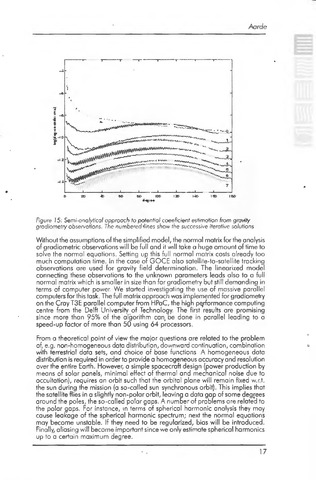Aarde
E
D -fc 6D t£> ICC IB l4C> I E OD
Figure 15: Semi-anafytical approach to potential coeeficient estimation from gravity
gradiometry observationsTne numbered-//nes show the successive iterative solutions
Without the assumptions of the simplified model, the normal matrix for the analysis
of gradiometric observations will be full and it will take a huge amount of time to
solve the normal equations. Setting up this full normal matrix costs already too
much computation time. In the case of GOCE also satellite-to-satellite tracking
observations are used for gravity field determination. The linearized model
connecting these observations to the unknown parameters leads also to a full
normal matrix which is smaller in size than for gradiometry but still demanding in
terms of computer power We started investigating the use of massive parallel
computers for this task. The full matrix approach was implemented for gradiometry
on the Cray T3E parallel computer from HPaC, the high performance computing
centre from the Delft University of Technology. The first results are promising
since more than 95% of the algorithm can be done in parallel leading to a
speed-up factor of more than 50 using 64 processors.
From a theoretical point of view the major questions are related to the problem
of, e.g. non-homogeneous data distribution, downward continuation, combination
with terrestrial data sets, and choice of base functions A homogeneous data
distribution is required in order to provide a homogeneous accuracy and resolution
over the entire Earth. However, a simple spacecraft design (power production by
means of solar panels, minimal effect of thermal and mechanical noise due to
occultation), requires an orbit such that the orbital plane will remain fixed w.r.t.
the sun during the mission (a so-called sun synchronous orbit). This implies that
the satellite flies in a slightly non-polar orbit, leaving a data gap of some degrees
around the poles, the so-called polar gaps. A number of problems are related to
the polar gaps. For instance, in terms of spherical harmonic analysis they may
cause leakage of the spherical harmonic spectrum; next the normal equations
may become unstable. If they need to be regularized, bias will be introduced.
Finally, aliasing will become important since we only estimate spherical harmonics
up to a certain maximum degree.
17

